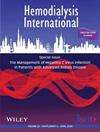Association Between Work Status and Quality of Life in End-Stage Renal Disease Patients During the First Year of Hemodialysis
Abstract
Introduction
End-stage renal disease patients have impaired health-related quality of life as compared to the general population due to the combined effects of the disease and hemodialysis (HD) therapy. As a result, poor quality of life increases their risk of mortality and hospitalization and affects their general well-being. While existing rehabilitation programs aim to improve physical activity in HD patients, the link between work status, particularly within the first year of treatment, and their quality of life remains unclear.
Objectives
This study aimed to compare the quality of life of working and nonworking end-stage renal disease patients during their first year of HD.
Materials and Methods
The comparative cross-sectional study involved 120 patients (60 working, 60 non- working) with end-stage renal disease at the hemodialysis (HD) centers during their first year of HD. Patients were administered the SF-36 survey to determine their physical and mental health levels. Statistical analyses, including Mann–Whitney U tests, Spearman's correlation, and multiple regression, were performed using SPSS 22.
Results
Employed patients demonstrated significantly higher physical functioning (MR = 82.37, Me = 41.27) and mental health (MR = 74.33, Me = 47.22) scores compared to non-employed (MR = 38,63, Me = 29.07 and MR = 46.67, Me = 38,14, respectively) (p < 0.001). Employment is a significant predictor of high quality of life (B = 11.6 for PF, B = 6.5 for MH). Despite older age and increased prevalence of comorbidities, employed patients demonstrate better quality of life results.
Conclusion
Employment has a positive effect on the quality of life of patients with chronic renal failure receiving HD, indicating that their regimen may be improved by incorporating work into the treatment program. Employment opportunities for patients with chronic renal failure receiving dialysis should be explored in the future.

 求助内容:
求助内容: 应助结果提醒方式:
应助结果提醒方式:


